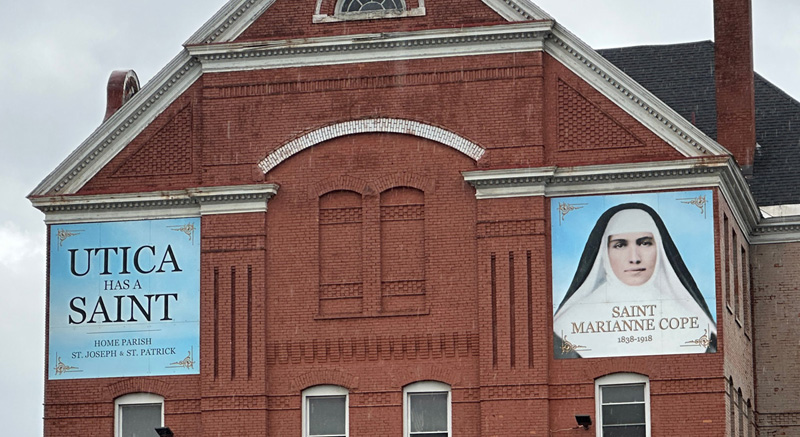Above: St. Marianne Cope is featured on the campus of St. Joseph St. Patrick Church in West Utica.
In this last of our series on local saints from Central New York and the Mohawk Valley, we present the “most local” of them all, St. Marianne Cope.
Barbara Koob (known as Marianne Cope) was born in Germany on Jan. 23, 1838. The year after her birth, her family moved to the United States and settled in Utica. She was educated at the St. Joseph School. When her father became disabled, she left school in the eighth grade to work in a factory to help her family. Barbara always harbored a desire to follow a religious vocation but remained at the factory until a month after her father’s death and her siblings were old enough to support themselves.

She entered the Sisters of St. Francis at age 24, taking the name Sister Marianne Cope. She soon became active in the field of education as a teacher and principal in several schools in Central New York. She was a dynamic presence on the governing board of her order, helping to establish two important medical centers: St. Joseph’s Hospital in Syracuse and St. Elizabeth Hospital in Utica. Her rule of offering people of all walks of life appropriate medical attention, even if they couldn’t afford it, made a tremendous impact on the communities she served.
Because of Sister Marianne’s willingness to accept medical students for clinical instruction at St. Joseph’s Hospital, the College of Medicine in Geneva, N.Y., moved to Syracuse University and became the College of Physicians and Surgeons in 1871. In the mid-1980s the name changed to the SUNY Upstate Medical Center and in 2000 SUNY Upstate Medical University. It is the region’s largest employer and the only medical center in Central New York.
By 1883, Mother Marianne was the mother general of her order and received a letter from King Kalakaua of Hawaii begging for assistance in caring for the sick of the kingdom. With six sisters, Marianne made the arduous voyage and met the challenge. In 1884, she established Malulani Hospital, the first general hospital on the island of Maui. She was asked to deal with the mistreatment of people with leprosy on the isle of Oahu.
Upon analyzing the situation, Mother Marianne demanded the government remove the administrator in charge or the sisters would return to Syracuse. Not only was she given full charge of the overcrowded hospital, but her planned return to Syracuse was delayed when the government and church decided her leadership was too important to the success of the mission to let her go.
A year later, in 1885, the Kapiolani Home was opened to save the homeless female children of patients with Hansen’s disease (leprosy). In this way, families could stay intact, and children could stay close to their parents. Only the Franciscan sisters had the desire or the knowledge to care for the families afflicted with the terrible disease.
During her ministry, Mother Marianne met future saint, the Rev. Damien DeVeuster, the “Apostles to Lepers.” She even cared for him when he came down with the disease. She helped demystify the fear of the afflicted by brokering a meeting between Father Damian and the royal family. A more open policy toward those with Hansen’s disease began to develop.
Unfortunately, in 1887, a new administration came to power in Hawaii and decided to close the Oahu hospital and reassumed former alienation policies. It was Mother Marianne and the Franciscan Sisters who would care for the sick and would be sent to the settlement for exiles on the Kalaupapa peninsula on the island of Molokai. By accepting this mission, Mother Marianne gave up forever her hope of ever returning to Syracuse. She was able to help Father Damien during the last two years of his life at the mission. She gave up the home for boys when she got relief from the Brothers of the Congregation of the Sacred Hearts of Jesus and Mary in 1895. She and the sisters continued to run the services for women and girls.
Mother Marianne died on Aug. 9, 1918. She was ahead of her time as an advocate for simple rules for healthcare, such as the washing of hands before administering to patience. As an educator she made sure patients and their children were literate and had practical skills. She made arrangements with local clergy to meet the religious needs of the community.
Furthermore, she believed in the creation of a pleasant environment through landscaping and an appreciation for aesthetics in the places she established. Her legacy lives on in the medical facilities of Syracuse, Utica and Poughkeepsie. Her lasting fame will, of course, always be tied to the medical services and compassionate institutions she established in the Hawaiian Islands.
Mother Marianne Cope was canonized by the Pope Benedict XVI on Oct. 21, 2012. Her presence is felt throughout our area, but particularly on Utica’s west side, the neighborhood in which she grew up and through the various agencies and good works that operate under her name.
